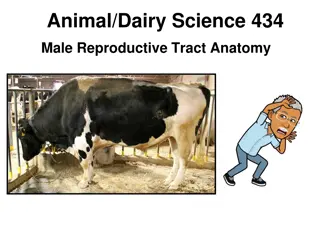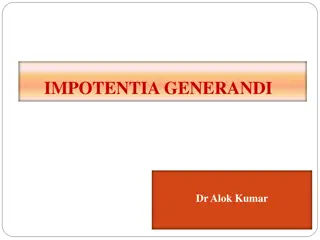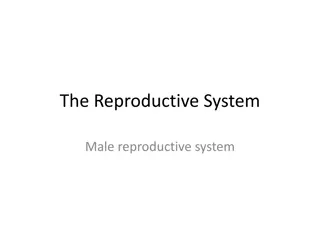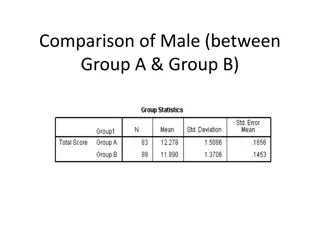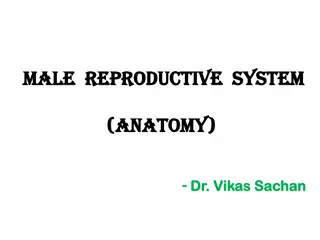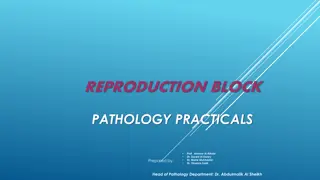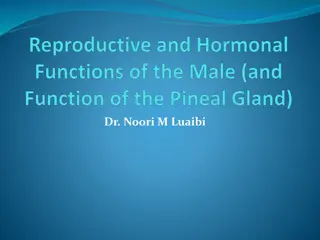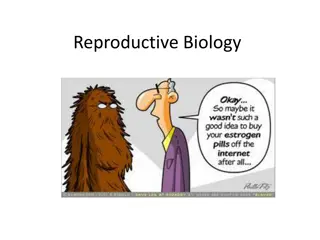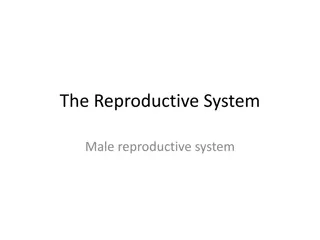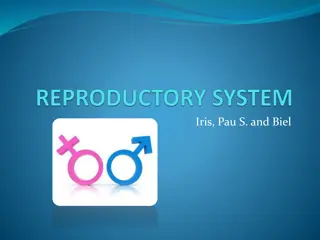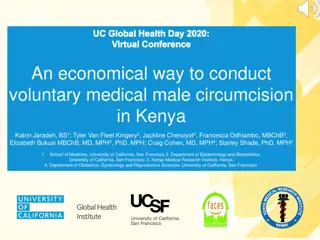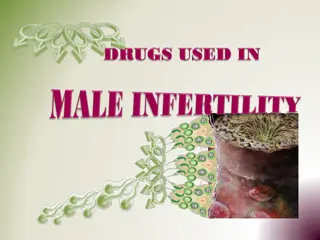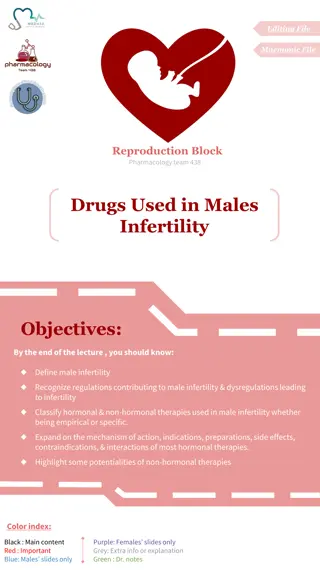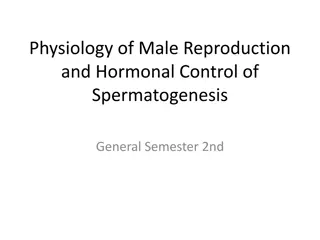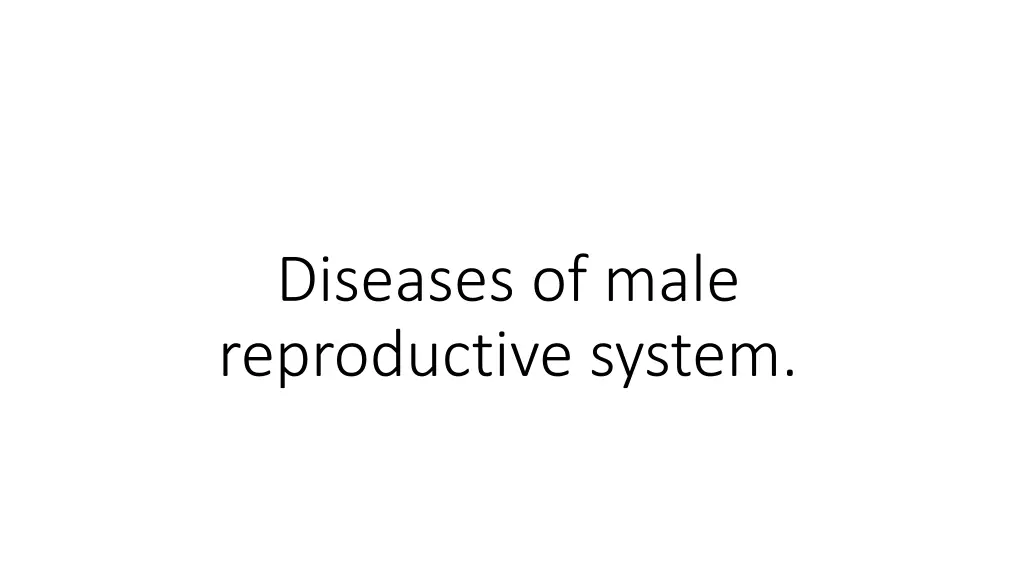
Understanding Prostate Disorders and Clinical Symptoms
Explore the pathology of the male genital system, focusing on prostate disorders, their manifestations, clinical symptoms, and examination methods. Learn about the impact on urinary tract function and potential complications.
Download Presentation

Please find below an Image/Link to download the presentation.
The content on the website is provided AS IS for your information and personal use only. It may not be sold, licensed, or shared on other websites without obtaining consent from the author. If you encounter any issues during the download, it is possible that the publisher has removed the file from their server.
You are allowed to download the files provided on this website for personal or commercial use, subject to the condition that they are used lawfully. All files are the property of their respective owners.
The content on the website is provided AS IS for your information and personal use only. It may not be sold, licensed, or shared on other websites without obtaining consent from the author.
E N D
Presentation Transcript
Diseases of male reproductive system.
pathology of male genital system prostate + seminal vesicles testicle + epidydymis testicle covering tissues + spermatic cord penis malformations regressive and dystrophic changes circulatory disorders inflammation tumors
Prostate The prostate is a retroperitoneal organ encircling the neck of the bladder and urethra. In the adult, prostatic parenchyma can be divided into four biologically and anatomically distinct zones or regions - the peripheral, central, and transitional zones, and the region of the anterior fibromuscular stroma. Testicular androgens control the growth and survival of prostatic cells. Castration leads to atrophy of the prostate caused by widespread apoptosis.
Prostate disordes manifestation gland enlargement proliferation of the prostatic tissue tumorous non-tumorous oedema general around pathological lesions (tumors, abscessi) bleeding deposites of pathologic material
Prostate disordes clinical symptoms urinary tract obstruction urinating disrorders and urine stasis risk of hydroureter, hydronephrosis, inflammatory complications pain at rest, by urinatinon, by sexual activity and ejaculation blood in urine or ejaculate in case of tumors lymphadenopathy (pelvic) complications of distant metastases lung embolism paraprostatic venous plexi thromboses accompanying gland enlargement
Prostate examination per rectum palpation imaging methods USG, MRI, CT, PET, fusion methods, scintigraphy biochemical markers and their dynamics PSA prostate biopsy several techniques acording to considered diagnosis aspiration cytology (rare), fine needle biopsy, transurethral (transvesical) resection, radical prostatectomy (open abdominal, laparoscopic, robotic asisted)
Prostate Only three pathologic processes affect the prostate gland: inflammation, benign nodular enlargement, and tumors. Of these three, the benign nodular enlargements are by far the most common and occur so often in advanced age that they can almost be construed as a normal aging process. Prostatic carcinoma is also an extremely common lesion in men
INFLAMMATION acute bacterial prostatitis chronic bacterial prostatitis chronic abacterial prostatitis granulomatous prostatitis
Acute bacterial prostatitis formerly Neisseria gonorrhoeae, often E. coli, Gram negative bacteria (Enterobacteriacae), Enterococci, Staphylococci ascendent infection spreading from urethra, by catheterisation, cystoscopy, complication of prostatolithiasis inflammation after diagnostic needle biopsy hematogenous infection rare clinic fever, dysuria, (less commonly haematuria, haemospermia), urine retention, urination urge, bacteriuria gross diffuse enlargement of the gland (oedema, hyperaemia) abscessi, map-like necroses histopahtology usually purulent inflammation glands filled with pus destruction of epithelium (spreading to interstitium) abscessi forming complications burst to surrounding tissues and structures acendent inflammation of urinary tract recover ad integrum / fibrosis / transformation to chronic prostatitis
Chronic bacterial prostatitis transforming of acute, slow development clinically dysuria, pain in back (often asymptomatic) risk of reccurent urinary tract infection in histology neutrophils, lymfocytes, plasma cells, macrophages both in glands and stroma risk of stones developing chronic non-bacterial prostatitis chlamydia, ureaplasma, mycoses (rare) same clinic manifestation like in chronic bacterial prostatitis urinary tract inflammation less common autoimmune prostatitis associated with serum IgG4 antibodies elevation differential diagnosis nodular inflammatory infiltrates accompanying hyperplasia and regressive changes other types of inflammation eosinophilic, parasitic, by systemic disorders (vasculitides) !!! present elevation of serous PSA (should decrease after treatment) !!!
Granulomatous prostatitis tuberculosis hematogenous metastases of lung tuberculosis porogenous spreading from other urogenital organs casseous colliquative character recovery by massive fibrosis and calcification (tumor imitation) tuberculous changes after BCG treatment of the bladder cancer Blastomycosis, Cryptococci, Histoplasma, mycoses rare, associated with immunosupresion (AIDS, post- transplantation) sarcoid rare in case of generalised sarcoid non-specific granulomatous prostatitis reaction on prostatic secret after epithelium destruction foreign body granulomas negative microbiology
Benign Prostatic Hyperplasia (BPH) or Nodular Hyperplasia BPH is an extremely common disorder in men over age 50. nodular enlargement (over 30 g) starting after 40th year incidence rising with age attention: it s hyperplasia, not hypertrophy androgen dependent disease dihydrotestosterone accumulation and its catabolism downregulation 5 -reductase overproduction no predisposition or protective factors clinic urination disorders frequent, painful, urine retention gross prostate enlargement nodular organisation of gland (irregular nodular shape) starts in periurethral zone the entire prostate involved
Benign Prostatic Hyperplasia (BPH) or Nodular Hyperplasia not a precancerous lesion however tumors still in differential diagnosis clinical complications bladder muscles hypertrophy, hydroureter, hydronephrosis (bilateral) urine retention secondary infections changed anatomical conditions catheterisation complications treatment resection (transurethral, transvesical) finasteride (testosterone to dihydrotestosterone conversion inhibition)
Precancerous lesions atypical proliferative changes in the glandular (luminal) epithelium cytologic and architectural risk of transformation to invasive carcinoma lesions surrounding own tumor
Prostatic intraepithelial neoplasia (PIN) ductal or acinar dysplasia 2 separated units according to prognosis and prediction of tumor transformation LG PIN younger patients, controversial role in cancer transformation HG PIN regular precancerosis risk of malignant transformation adhaerent of number of foci found in biopsy often in peritumorous location
TUMORS When the terms prostate cancer are used without qualifications it refers to the common or acinar variant of prostate cancer. Characteristically, on cross-section of the prostate the neoplastic tissue is gritty and firm and hardly distinguishable from surrounding normal tissue. Local extension most commonly involves periprostatic tissue, seminal vesicles, and the base of the urinary bladder, which in advanced disease may result in ureteral obstruction.
Prostatic carcinoma morphology and localisation peripheral zone minor part in transitional zone yellow to grey coloured hard tissue difficult identiffication (after fixation) possible multifocal occurence
grade rating of tumor differentiation influence on tumor prognosis several grading systems during the 20th century most reliable and about prognosis predicable is Gleason s grading system grading of the prostate carcinoma Donald F. Gleason (1920 2008)
1966 2005 2015
G1-2 G3 G4 G5
Testicle male genital gland - gonade anatomy and histology optimalized for basic function of the gland complex paired organ localized in the scrotum testicle epididymis and supporting structures covering tissues several functions production and maturation of sperms hormone production widespread pathological affections
embryogenesis development from urogenital crest in the abdominal cavity and retroperitoneum begining around 4th week of embryonal development chromosomal and hormonal determination descensus to scrotum (starts in 12th week) stepwise descent through inguinal canal finalized usually by birth (not mandatory) pathologic changes based on genetics, hormonal influence and descensus
histology seminiferous tubules germ cells spermatogenesis supporting cells (Sertoli cells) interstitium blood and lymphatic vessels, nerves collecting ducts hormone production (Leydig cells)
Pathology of the testicle pathology of the own gland pathology of covering and supporting tissues manifestation damage of the testicular parenchyma sperm maturation defect (infetrility) often painful dissemination of tumors oncologic consequences pathology of the own gland pathology of covering and supporting tissues manifestation damage of the testicular parenchyma sperm maturation defect (infetrility) often painful dissemination of tumors oncologic consequences
Atrophy of the testicle different causes temperature elevation, pressure, postinflammatory changes, hormonal influence, cachexy, circulatory and vascular changes atenuation of tubules loss of germ cell epithelium and Sertoli cells depletion up to loss of spermatogenesis sclerotisation of tubules interstitial fibrosis
Circulatory disorders haemorrahgic necrosis (haemorrhagic infarsation) testicle torsion rotation around the axis acute beginning (seconds) , severe pain testicle palpatory hard the entire testicle necrotic with haemorrhage vascular thromboses damage of the parenchyma
Circulatory disorders anaemia pressure on testicle and blood vessels (hydrocoele, varicocoele) hyperaemia varicocoele haemorrhage post-traumatic peritumorous haematocoele
Pathologic resistance in the scrotum generally any resistance (expansion) in the scrotum widespread differential diagnosis (malformation, inflammation, pathologic material, trauma, tumor) proper diagnosis proper treatment
Inflammation of the testis = orchitis, orchiepididymitis more often epididymis affected (and begining of the inflammation here) variable aetiology infectious bacteria, mycoses, viruses non infectious systemic disorders and vasculitides frequent in patients with immunosupression spreading ascendent relationship to urinary infections Neisseria gonorrhoae, uroinfections hematogenous (uncommon) epidemic parotitis
Orchitis different types of inflammation according to aetiology type of inflammatory exsudate serous, lymphoplasmocytic, purulent, granulomatous inflammation spreading diffuse (phlegmonous) inflammation with destruction of tubules and interstitium forming of abscessi and granulomas proliferative phase and reparation conclusions fibrosis, dystrophic calcifications germ cell epithelium destruction damage of sperm production and maturation, infertility damage of endocrine funcions
Specific and granulomatous orchitis tuberculosis beginning and most cases in epididymis infication hematogenous spreading from primary complex spreadin from prostate and seminal vesicles 2 forms exsudative caseous tuberculosis caseous exsudate in lumen of tubules containing mycobacteria porogenous spreading and phistules productive tuberculosis forming of specific granulation tissue recovery by extensive fibroproduction
Testicular tumors variable group of tumors reflecting complicated histogenesis of the testicle different histology and biological behaviour benign, malignant, uncertain biological potential pseudotumorous and precancerous lesions in combination with tumors or mimicking the tumors intratubular neoplasia (dysplasia) hyperplastic processes
germ cell tumors seminoma non-seminomatous non-germ cell tumors sex-cord (stromal) tumors miscellaneous haematologic tumors collecting ducts tumors tumors of paratesticular tissues mesenchymal tumors of spermatic cord and testicular adnexa secondary tumors WHO classification of testicular tumors (2016)
Germ cell tumors more than 90% of all primary testicular tumors most of them malignant typical age of manifestation classification into 2 groups according to association with precursor lesion attendance of germ cell neoplasia in situ different prognosis and therapeutic attitude morphology of fetal developmental tissues production of specific proteins (biochemical follow up) malignant tumors with different agressivity often already metastatic disease in time of the primary diagnosis pure forms seminoma, embryonal carcinoma (EC), yolk sac tumor (YST), trophoblastic tumors, teratoma germ cell tumors NS, germ cell tumors without association with GCNIS mixed combination of several types of germ cell tumors
Seminoma typical age 30-49 years solid, homogenous, pinkish nodule possible necrosis locally destructive growth histopathology solid, alveolar and trabecular organisation polygonal cells with pale (clear cell) cytoplasm containing glycogen (PAS+) well visible cell membranes fibrous septa in interstitium lymphoplasmocytic infiltrate

